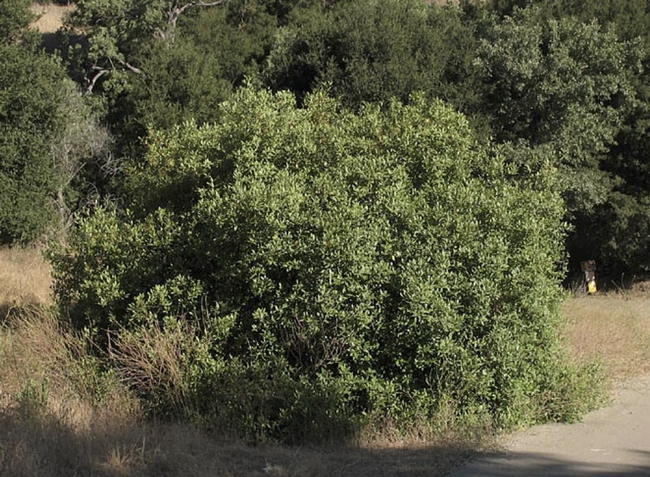
One plant I'm confident has been on the top ten from the beginning is California coffeeberry. Coffeeberry is a member of the Rhamnaceae, or Buckthorn family. I've always known it as Rhamnus californica, but recently it has been reclassified as Frangula californica.
Many of you are probably familiar with coffeeberry, as it is one of the most widespread plants of the California landscape. I normally associate it with the chaparral and oak woodlands, but one or more of its subspecies can be found in nearly every community throughout the state. You can see an interesting map of its distribution here or go to the CalFlora website. Locally, I have encountered coffeeberry only occasionally, most notably in the south fork of Big Pine Creek. Then just yesterday, I saw some tremendous specimens up a little side canyon near the creek crossing on Baker Creek Road.
When I found coffeeberry at a nursery years ago, I knew it only from the Santa Cruz mountains, and I wasn't even aware it occurred on the eastside, so I considered it 50-50 that it would make it through the winter. Though the leaves do look a bit stressed by the end of the winter, it always comes roaring back in the spring. I made my first planting close to the house, thinking it would benefit from the extra protection, but I have planted several more over the past dozen years, and all have thrived (“thrived” being a relative term here in the far western reaches of Chalfant!). The other foundations of my landscape as far as evergreen broadleaved shrubs are mountain mahogany, bitterbrush and sugar bush. While I don't trust coffeeberry to be as cold tolerant as the first two, which are more common local natives, it is hardier than the last, Rhus ovata, a native of the SoCal coast ranges (but which I first noticed in Sedona) that is definitely another of my top ten shrubs.

Depending on the authority you consult, there are between two and six subspecies and several named cultivars. I have one I purchased as a tiny baby from the Bristlecone Native Plant sale (ssp. californica?) maybe eight years ago that is now six feet tall. From Theodore Payne Nursery near San Fernando, I purchased Frangula californica tomentella, which has done less well, but it is in a very challenging location and still looks pretty good. My others are all the widely available ‘Eve Case' cultivar. The descriptions online say that ‘Eve Case' is somewhat smaller than the species, but that has not been the case for me. In my yard, the natives seem to have smaller, less glossy leaves. I have some plants that get water daily during the growing season and others that get a soaking every week or two. All have done well. You can just leave them alone and they look great, but they take kindly to any amount of pruning. I have even cut them back to the ground, and they crown sprout beautifully. In my yard they seem to reach a height and width of about eight feet, but, as I said, they are very amenable to whatever size you want to make them!
This is not the easiest plant to find, but a few individuals do show up each summer in our local nurseries, and they are widely available in native plant nurseries throughout the state. So bypass those boring shrubs at the big box stores, go your local nursery and ask them nicely to order a few coffeeberry plants for you (one gallon is fine if you can get it). You will not be disappointed, and the birds and the bees will definitely thank you.
